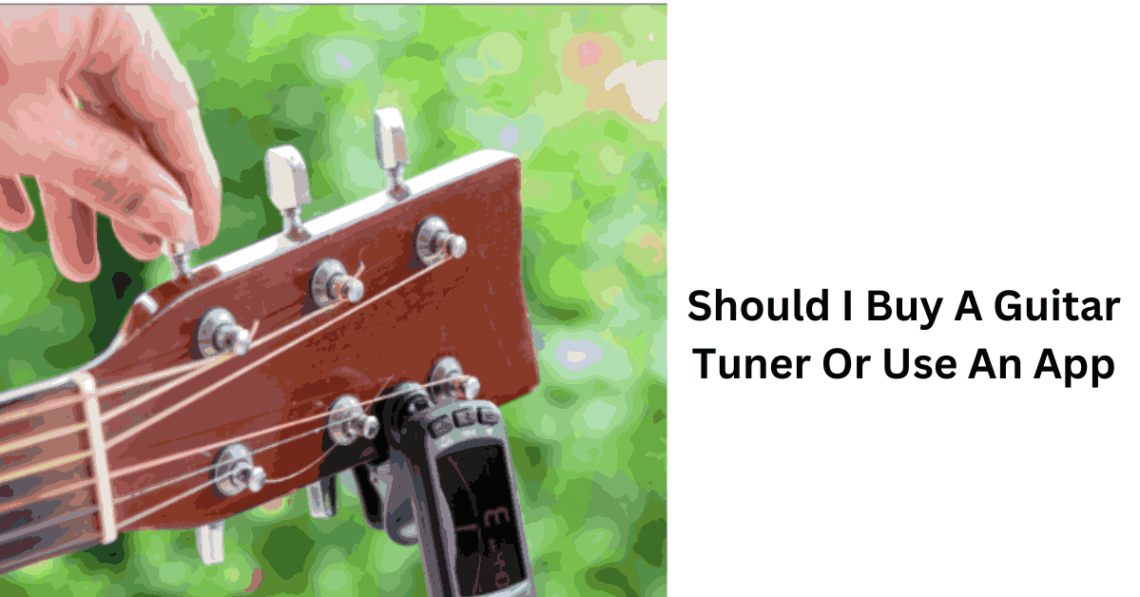
Should I Buy A Guitar Tuner Or Use An App
Hitting the right notes is music to everyone’s ears, literally!
However, maintaining perfect tuning can feel like an endless battle for the guitarists. Whether you’re a seasonal shredder or starting out learning the instrument, keeping your instrument in tune is crucial for pitch and harmony.
When it comes to tuning, the choice between a dedicated guitar tuner and a tuning app can be a real head-scratcher. Both options have dedicated users.
However, which one is the supreme for accuracy, portability, and ease of use?
Fear not, fellow musicians! Let’s dive deep into the pros and cons of each approach and help you find your perfect pitch partner!
How Do Guitar Tuners Work?
A guitar tuner is a handy tool for tuning your guitar, relying on detecting the pitch of the strings and displaying it on a screen. Many tuners come equipped with a built-in microphone, eliminating the need for an external one.
These devices pick up the pitch of the sound waves generated by the vibrating guitar strings.
The detected pitch is showcased on a screen, indicating whether the string is too high or low. For instance, if the tuner shows that note E is too low, the player would adjust the string tension, typically by tightening it, to bring the pitch to the correct level.
The guitar tuner apps operate similarly to traditional tuners. Instead of relying on a physical device, they utilize the microphone of your phone or tablet. The app displays this information on the screen by listening to the pitch of the sound waves generated by the vibrating guitar strings.
Like their physical counterparts, these apps inform the player whether the string is too high or low in pitch.
Different Types of Tuners
Chromatic tuners
Chromatic tuners are widely used, compatible with various instruments, and can detect a broad spectrum of pitches. While most feature a built-in microphone, some also accommodate external microphones.
In the context of tuners, the term “chromatic” signifies the ability to tune to every note in the chromatic scale, a series of twelve pitches separated by semitone intervals.
Unlike non-chromatic tuners, limited to recognizing notes in standard guitar tuning (EADGBE), chromatic tuners offer flexibility.
They enable tuning in alternative tunings like drop D, open D, G E, and flat tuning.
With a chromatic tuner, you can tune to any note on your guitar, and it will display how flat or sharp you are relative to the nearest semitone, providing comprehensive tuning options across different playing styles and musical preferences.
Polyphonic Tuners
Polyphonic tuners represent a newer trend in tuning technology, capable of detecting multiple pitches simultaneously. This feature is particularly beneficial for guitarists as it allows for tuning all strings simultaneously, eliminating the need to pluck them individually.
The primary advantage of polyphonic tuners lies in their speed and accuracy. By detecting multiple pitches at once and considering the relationships between the strings, they can quickly and precisely tune the instrument. This is especially valuable for live performers or those playing in front of an audience.
However, it’s worth noting that polyphonic tuners are more expensive than chromatic tuners, which could influence their accessibility for some musicians.
While they offer significant benefits, they may not be the most practical choice for everyone due to their higher cost. Nonetheless, it can be a valuable investment for those who prioritize speed and accuracy in tuning polyphonic tuners.
Microphone
A microphone, on its own, isn’t sufficient for tuning your instrument. However, it’s a crucial component for specific tuning methods, such as those used in web-based guitar tuners. These tuners rely on the microphone to capture the sound of your instrument.
Microphones used for tuning can be either built-in or external, depending on the device or application. Regardless of their form, they serve a vital role in scenarios where vibration sensors aren’t utilized to detect the pitch of a string.
While these microphone-based tuners are less precise than those using vibration sensors, they are generally more affordable and still capable of effectively tuning your instrument.
However, they may pick up background noises and the instrument’s sound, potentially impacting accuracy for many musicians, especially those on a budget, microphone-based tuners are a good starting point for tuning.
Strobe
Strobe tuners, known for their exceptional accuracy, are considered top-tier but have a higher price tag. The term “strobe” is short for “stroboscopic.”
These tuners excel at displaying the difference between a reference frequency and the musical notes being played. They can even detect subtle variations between the two.
They achieve this precision by utilizing a mechanical spinning disk with a strobe pattern illuminated by lights flashing at a rate similar to the frequency of the analyzed signal.
As you tune a string correctly, the speed of the spinning disk synchronizes with the flashing lights, creating the illusion of the disk appearing stationary. While they may be more costly, their unparalleled precision is worth it for professionals.
Mobile Tuner Apps (Android/iOS)
Mobile app tuners are the new-age solution to guitar tuning. They are usually very user-friendly and convenient options for tuning guitars.
Thanks to advancements in smartphone technology, the microphones embedded in these devices have improved significantly, leading to more reliable tuner apps.
With minimal ambient noise, most tuner apps have impressive accuracy, typically within a range of +/- 1-3 cents. It’s worth noting that the human ear can only discern pitch changes of about 5 cents.
While there may be slight discrepancies in tuning compared to the most precise tuners available, for the average user, the difference is negligible.
In practice, tuning a guitar with a top-of-the-line tuner versus using a mobile app may yield a slight discrepancy, but it’s unlikely to be noticeable to the average person. Mobile apps provide a convenient and effective solution for everyday tuning needs, offering sufficient accuracy for most players.
Conclusion
When it comes to choosing between dedicated guitar tuners and guitar tuner apps, it boils down to individual preferences and requirements as a musician. Both options offer their own set of advantages and drawbacks.
If you prioritize accuracy and reliability and are willing to invest, a dedicated guitar tuner might be the optimal choice. These tuners are precise and ideal for those who want the utmost accuracy in guitar tuning.
On the other hand, if you’re looking for a more budget-friendly and portable solution with added features, a guitar tuner app could be the better fit.
You May Also Like

Popular CFD Instruments in Australia (2023)
September 15, 2023
The Future of Technology: Exploring the Latest the techno tricks
April 18, 2023

